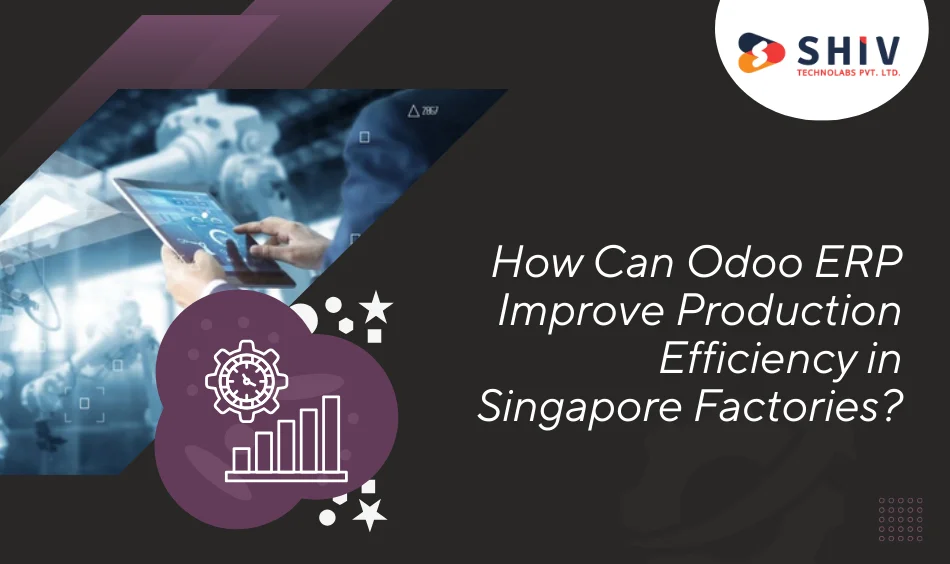Table of Contents
Singapore’s factories are moving into Industry 4.0, where connected machines and data guide daily decisions. Many plants pick Odoo ERP for manufacturing in Singapore and partner with an Odoo development company Singapore. This pairing gives clear rollouts, faster adoption, and shop-floor support that matches local regulatory needs.
Odoo’s modular apps fit unique workflows and give live dashboards across machines, materials, and teams. The platform links with IoT, robotics, and AI, supporting predictive maintenance and accurate capacity planning. Finance, sales, and operations share the same view, so leaders act faster and with greater confidence.
This guide explains why smart factories matter in Singapore and how Odoo turns plans into measurable gains. You will also see practical wins in production and supply chain, plus partner selection tips. Use this roadmap to move from pilots to scale while protecting margins and delivery commitments.
Why is Smart Factory Transformation Important for Singapore Manufacturers?
Competition is tight, labor costs are high, and buyers want short lead times with steady quality. Smart factory programs help plants lift output, curb rework, and protect margins in crowded markets.
Government support for digital transformation in Singapore’s manufacturing reduces adoption risk and encourages faster pilots. Funding, capability centers, and training bring confidence to leaders planning factory upgrades and connected operations.
Drivers and outcomes at a glance
| Driver / Context | What it means day to day | Outcome for manufacturers |
|---|---|---|
| Tight competition | Pressure on price and speed | Shorter cycles and better cost control |
| High labor costs | Hiring and retention challenges | More automation and smarter shifts |
| Government support | Funding and capability programs | Lower adoption risk and faster pilots |
| Buyer expectations | Short lead times and steady quality | Reliable deliveries with traceability |
| Compliance demands | Audit trails and product records | Clean data and easier audits |
Top benefits you can expect
- Automation where it matters reduces manual steps, limits errors, and stabilizes output on busy, multi-line operations.
- Real-time monitoring delivers live views for machines, work orders, materials, and shipments across multiple sites.
- Predictive insights flag maintenance needs early and warn planners about demand shifts or supplier delays.
- Connected data shortens decision cycles across production, inventory, finance, and sales, keeping teams aligned daily.
- Scalable growth lets you add modules, device links, and sites as volume rises or product mix changes.
With a clear roadmap and the right ERP core, teams act quickly on real shop-floor signals. Factories cut downtime, speed deliveries, and accept new orders confidently, even when demand shifts without warning.
How Does Odoo ERP Support Smart Manufacturing in Singapore?

Smart manufacturing needs a modular platform that grows with the plant and links every core process. Odoo gives factories in Singapore a practical suite that fits budgets, timelines, and shop-floor reality. The result is a smart manufacturing ERP approach that supports fast change without heavy overhead.
What the modular approach delivers
- Modular apps for production, inventory, quality, maintenance, and finance, added in the order your plant needs.
- One data model across teams, so planning, purchasing, and scheduling act on the same live numbers daily.
- Role-based dashboards that show operators, planners, and leaders the actions that matter right now.
- Open APIs for machine data, vision systems, and test rigs, with clear hooks for future devices.
- Low total cost compared to heavy legacy suites, with fast pilots and measurable early wins.
Odoo connects the ERP core with IoT sensors, robots, and AI services used on modern lines. Gateways send machine signals to Odoo, so maintenance, quality, and planning work from current readings. Our Odoo ERP implementation Singapore projects configure these links, train teams, and align settings with local factory practices.
Integration map at a glance
| Odoo | Factory tech link | Result on the floor |
|---|---|---|
| Manufacturing | PLCs, cobots, vision counters | Faster cycle feedback and fewer stoppages |
| Maintenance | Condition sensors, vibration logs | Earlier service calls and lower repair costs |
| Quality | Cameras, torque guns, testers | Traceable checks and tighter tolerances |
| Inventory | RFID, scales, handhelds | Accurate counts and cleaner putaway moves |
| Planning | Demand signals, AI forecasts | Smoother schedules and fewer changeovers |
Data drives daily decisions when Odoo ties shop-floor events to orders, lots, and serials. Teams see scrap, rework, and yield in context, not in isolated spreadsheets. Leaders get alerts when bottlenecks form, so they act before targets slip.
Factories also gain safer rollouts with clear separation between test and live environments. Teams try new flows in a sandbox before switching lines, avoiding shocks during busy periods. Standard profiles make onboarding faster, while audit trails keep compliance ready for checks anytime.
A typical setup follows a short, focused path that respects production calendars. Start with a pilot cell and one warehouse lane, then scale by product family or site. Each wave locks gains and adds new device links based on real feedback.
Recommended rollout steps
- Pick a high-impact line with stable demand and strong supervisor support.
- Map data sources, machine tags, and required alerts for that line.
- Configure work orders, barcodes, quality points, and maintenance plans.
- Test, train, and run a time-boxed pilot with clear success metrics.
- Expand to nearby lines, then extend to suppliers and logistics partners.
When factories pair Odoo’s modular core with careful device links, gains arrive quickly. Teams ship faster, waste less, and keep promises with confidence, even when demand shifts mid-month.
What Are the Key Odoo ERP Modules for Manufacturing?
Smart factories run best when core processes sit on modular building blocks that fit each team. This section highlights Odoo ERP modules for manufacturing and shows how they deliver fast, measurable wins. Each module focuses on a clear job, and together they raise speed and control across daily operations.
Many plants start with Odoo ERP production management in Singapore because planning and execution set the daily tempo. From there, teams add inventory, quality, maintenance, and finance to round out control and visibility. That sequence lowers risk, builds confidence on the floor, and delivers measurable gains within the first month.
Core modules and what they do
- Production Management: Plan work orders, balance capacity, track OEE, and guide operators with barcodes and real-time steps.
- Inventory Management: Control lots and serials, run FEFO/FIFO, manage multiple sites, and track every move with handhelds.
- Supply Chain: Run smart reordering, vendor scorecards, RFQs, and logistics with ASN support and dropship options.
- Quality: Add in-line checks, record nonconformances, trace root causes, and keep full product history for audits.
- Accounting & Finance: Track standard and actual costs, value WIP, analyze margins, and post entries from live production data.
These modules share one data model, so planners, buyers, and supervisors rely on the same live facts. Change a plan, and related reservations, purchase needs, and labor schedules reflect that change within minutes. Leaders gain clear visibility from order promise dates down to the last scanned component.
Traditional ERP vs Odoo ERP – modules at a glance
| Aspect | Traditional ERP | Odoo ERP |
|---|---|---|
| Features | Broad functions with heavy preset workflows and long change cycles | Focused apps with quick setup, clear tweaks, and fast wins on the floor |
| Flexibility | Customization needs long projects and vendor tickets | Configuration-first with open APIs and fast, targeted extensions |
| Cost | Large upfront licenses and costly upgrades | Lower entry cost, pay-as-you-grow apps, and quick pilot-to-scale paths |
A modular path makes upgrades safer and training easier for growing teams. New hires learn role-based screens without digging through crowded menus. Supervisors spend less time chasing spreadsheets and more time guiding cells, fixing bottlenecks, and protecting delivery dates.
Selection tips for your first wave
- Pick modules tied to today’s delays, not tomorrow’s wish list.
- Start with one line and one warehouse lane to prove value early.
- Use barcode flows and role dashboards to cut onboarding time.
- Add maintenance and quality once schedules and counts run clean.
- Bring finance into the loop to track costs and margins in real time.
With the right module set, factories move faster, waste less, and promise dates with confidence. As volume grows, adding apps and device links stays simple, so gains keep compounding across sites and product families.
How Can Odoo ERP Improve Production Efficiency in Singapore Factories?

Plants raise output when planning, execution, and feedback run on one source of truth. With Odoo ERP production management Singapore, supervisors plan work orders, balance capacity, and guide operators with clear, role-based screens. Teams apply lean methods – standard work, Kanban moves, and quick changeovers—without heavy admin or scattered spreadsheets.
Live shop-floor data drives smarter schedules. Predictive rules account for machine calendars, labor shifts, and material readiness before an order hits the line. IoT signals and barcode scans update progress instantly, so planners react to events with confidence and protect delivery dates.
Efficiency wins at a glance
- Reduced downtime
- Real-time resource planning
- Machine integration support
- Faster product delivery
Supervisors see bottlenecks early, reroute tasks, and lock in steady cycle times during peak demand. Operators follow simple steps and scan points, cutting errors while keeping quality checks tight. Finance reads actual costs from production events, giving leaders clear margin insight on every order.
How Does Odoo ERP Handle Inventory and Supply Chain in Manufacturing?
Modern plants need accurate counts, fast picks, and supplier signals that match real demand. Odoo ERP inventory management Singapore gives clear location control, batch and serial tracking, and FEFO/FIFO rules that keep moves clean. Rules drive smart reordering, while handhelds and RFIDs record every transfer across sites.
For procurement and logistics, Odoo ERP for supply chain Singapore adds RFQs, vendor scorecards, and shipment plans tied to real production needs. Teams plan inbound docks, cross-docks, and outbound waves with dates that reflect current capacity. ASN flows and carrier links help warehouses stage and ship without last-minute chaos.
What you gain day to day
- Stock automation that places the right item in the right bin, at the right time.
- Multiple warehouse handling with transfers, quarantine zones, and consignment support.
- Supplier tracking with lead times, MOQs, and on-time ratings tied to real receipts.
- Shipment planning that aligns picks, packing, and carrier cut-offs with live orders.
Benefits of Odoo ERP for supply chain vs manual systems
| Area | Odoo ERP approach | Manual systems | Benefit to the plant |
|---|---|---|---|
| Replenishment | Rules, min/max, lead times tied to demand | Spreadsheets and guesswork | Fewer stockouts and lower excess |
| Traceability | Lots/serials, scan trails, QA holds | Paper logs and ad hoc tags | Faster recalls and cleaner audits |
| Warehousing | Bin rules, waves, RFIDs, handhelds | Mixed labels and manual counts | Quicker picks and fewer errors |
| Supplier control | Scorecards, ASN, delivery SLAs | Email chains and static lists | Better OTIF and shorter shortages |
| Shipping | Rate shop, cut-offs, labels | Late prints and phone calls | On-time dispatch and fewer fines |
When inventory and supply chain run on current facts, plans stick and orders ship on time. Teams waste less effort on rework, emergency buys, and late-night counts. Leaders protect margins while giving customers reliable dates, even when demand spikes without warning.
Why Should Singapore Manufacturers Consider Odoo ERP Implementation?
Leaders want faster rollouts, clear returns, and low risk from Odoo ERP implementation Singapore projects. Odoo supports phased adoption, real-time data, and tight control across lines, warehouses, and finance. You start small, prove value on one line, then expand by product family or site.
Clear gains you can target
- Faster pilots that land within planned production windows.
- Lower entry cost with pay-as-you-grow apps.
- Phased waves that protect delivery dates and margins.
- Built-in traceability that keeps audits ready.
What Are the Challenges in Adopting Odoo ERP for Smart Manufacturing?
Any ERP program can face hurdles across people, data, and daily routines. Plan early, involve supervisors, and keep pilots tight so wins appear fast.
Typical hurdles and practical responses
- Initial costs → start with a narrow, time-boxed pilot.
- Change management → train by role and coach supervisors daily.
- Employee training → use barcode steps and visual work guides.
- Data migration → clean masters and test cutovers in a sandbox.
How to Choose the Right Odoo ERP Partner for Singapore Manufacturing Firms?
Pick specialists who understand factories, not just software. Ask for proof on similar lines, device links, and regulatory needs in Singapore. Shiv Technolabs brings Singapore plant experience, clean Odoo builds, and hands-on coaching that fits shift patterns and audit needs.
Partner selection checklist
- Local project experience with Singapore plants and auditors.
- Strong background in discrete and process manufacturing.
- Configuration-first builds with clean, supportable extensions.
- Device integration skills for PLCs, scanners, sensors, and gateways.
Conclusion
Smart factories in Singapore need an agile ERP core that supports quick change, clean data, and reliable deliveries. Odoo gives a modular path that raises output, cuts waste, and aligns finance with operations in real time. Work with a trusted Odoo partner Singapore to plan pilots, train teams, and scale across sites without slowing the floor. Start your transformation journey today with a focused pilot, clear metrics, and a roadmap that grows as demand rises.
FAQs
How does Odoo ERP help Singapore manufacturers adopt Industry 4.0?
It connects planning, machines, and data, so teams act on live signals and raise output quickly.
Which Odoo ERP modules are most useful for smart factories in Singapore?
Production, Inventory, Quality, Maintenance, and Finance deliver fast gains in speed and traceability.
Is Odoo ERP suitable for SMEs in Singapore’s manufacturing sector?
Yes. Start small, prove value on one line, then expand by family, site, and vendor links.
How long does Odoo ERP implementation take for a factory in Singapore?
Pilots land in weeks. Phased waves follow production calendars and scale by demand.
Can Odoo ERP integrate with IoT devices in smart factories?
Yes. Open APIs and gateways connect sensors, PLCs, and scanners for real-time events and alerts.

























